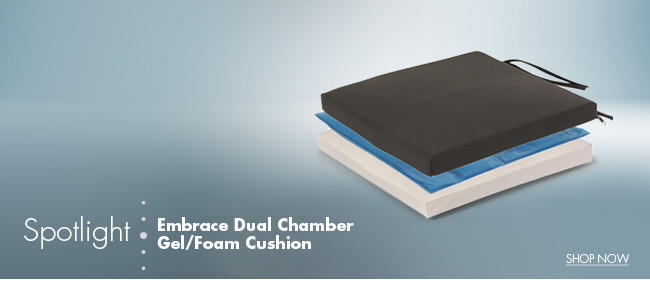 |
 |
| |||
|
|
There are hundreds of wheelchair cushions to choose from, and the best choice for an individual resident depends on many factors. Body type makes a difference. Thinner residents with less padding over their bones need to be sure their hip bones are well-protected by a cushion. Pelvises come in different sizes, which also influences the choice of cushion. The height of the cushion also needs to be considered. The length of footrests, the height of the chair back and the position of armrests are all influenced by how high or low a resident will be sitting on a cushion. Sometimes a thicker cushion means the resident can no longer fit under a table. Foam Cushions Foam cushions are the best known and most often used; they’re inexpensive and lightweight. These types of cushions also possess varying degrees of “memory,” for better molding of the users shape and adding stability. On the downside, foam wears out faster than other material and old foam that is compressed can lead to pressure sores. Gel or Gel-Foam Cushions Gel and gel-foam cushions can be contoured for postural support and are excellent at pressure distribution. They attempt to replace the consistency and support of atrophied muscle tissue, creating a harder surface than foam. Gel cushions need careful attention because the gel or fluid can shift, and therefore may need adjustment or replacement. Air or Roho-style Cushions These cushions can provide good pressure distribution when properly inflated. They have multiple interconnected air cells that evenly distribute pressure or can be adjusted to the resident’s specific needs. The air pressure should be checked often to be sure the cushion is working properly. Air cushions are frequently chosen for individuals who have a history of pressure sores or those at high risk due to lack of sensation and decreased ability to shift positions. Time to Replace Your Cushion? Most wheelchair cushions have an expected life of one-two years. A worn-out cushion means a resident may be “bottoming out,” that is, the cushion is no longer supporting the hip bones and they are sitting on the cushion base with no support and putting them at risk. As a wheelchair cushion develops wear, it no longer offers comfort, support or protection from sores. Professional Medical offers a comprehensive line of pressure reduction seating to meet your residents’ needs. To learn more contact you ProMed territory manager, give us a call at (800) 648-5190 or visit us online at promedsupply.com. Reference 1 http://quest.mda.org/article/cushion-comfort (Excerpted from:Cushion Comfort: The right cushion makes all the difference). February 2016. |
 |
 |
|
Professional Medical will be closed Friday, March 25 in honor of Good Friday/Easter. Orders placed by noon on Monday, March 21 will be delivered by Thursday, March 24. Please call our Customer Care department at (800) 648-5190 if you have questions or concerns. |
 |
 |
|
The Embrace® Dual Chamber Gel/Foam Cushion assists in the prevention and treatment of pressure ulcers. Additional features:
|
 |